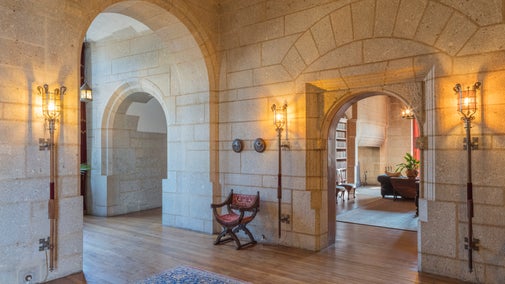
Discover more at Castle Drogo
Find out when Castle Drogo is open, how to get here, the things to see and do and more.

Hydroelectric power produced using the force of the Teign Gorge was introduced at Castle Drogo in 1927. Visitors can discover more about this greener energy source at the castle and how it came to be built here. Find out below how the machinery that generates the power fell into disrepair and the reasons it was restored to full working order.
The story of hydroelectric power at Castle Drogo began in 1916. While Castle Drogo was being built, Julius Drewe wrote to Gilbert Gilkes and Co. to enquire whether it was possible to use energy from the River Teign.
Gilbert Gilkes and Co. were a well-established engineering company specialising in hydro-electricity generation and are still based in Kendal today and continue to supply the National Trust with turbines.

Work started in 1927 after Sir Edwin Lutyens designed the castle. Gilbert Gilkes and Co. were then able to install two turbines. By March 1929 the turbines were producing electricity that supplied the castle.
At this time there were 332 electrical plug sockets installed throughout the castle to power all of the gadgets in Julius Drewe’s thoroughly modern home.
The supply wasn’t always reliable, as one family member recalls, ‘when it was windy the power was unreliable and mother was never able to have a washing machine’.
Over time the turbine house fell into disrepair. Other methods of receiving electricity through mains distribution from energy suppliers became increasingly popular across the country.
As part of the National Trust’s aim to produce 50 per cent of our energy from renewable sources by 2020, we've returned the building to its original purpose and reinstated the hydro scheme.
The majority of the original infrastructure was reusable. The two original Francis turbines were sensitively restored and the three feet diameter concrete pipe that takes the water from the river weir to the turbine house was in good condition.

The project also required the installation of new elements. These included an intake screening system to ensure that fish and eels cannot enter the turbine. A new cable has also been installed to bring the power directly to the visitor centre.
The turbine house is now generating electricity for the visitor centre and any excess is used to pre-heat water in the castle’s heating system reducing the amount of biomass needing to be burnt so there's no wastage of power.
As long as there's always sufficient water in the River Teign then power can be generated through this renewable resource.

Find out when Castle Drogo is open, how to get here, the things to see and do and more.

Throughout the year the hydro is opened to the public on selected days. Keep an eye out on our events page and social media for dates in 2025
Find out how Castle Drogo has been conserved using a combination of high-tech and heritage building materials. Discover how the work was funded through generous donations.

Explore the castle’s interior and discover its precious treasures and family stories. As the last castle to be built in England modern features were included for the ambitious owner.

Follow the winding paths below the castle into the sheltered Teign Gorge. Explore this ancient gorge teeming with wildlife on trails along the river or soak up views over Dartmoor.

Castle Drogo’s garden is the highest garden cared for by the National Trust. Discover circular lawns, formal terraces, a rhododendron garden and a tranquil Chapel Garden at this castle garden on Dartmoor.

We believe that nature, beauty and history are for everyone. That’s why we’re supporting wildlife, protecting historic sites and more. Find out about our work.

Discover which of the places in our care generate their own hydroelectricity, from a 19th-century 'smart home' in Northumberland to a state-of-the-art water turbine in scenic Snowdonia.